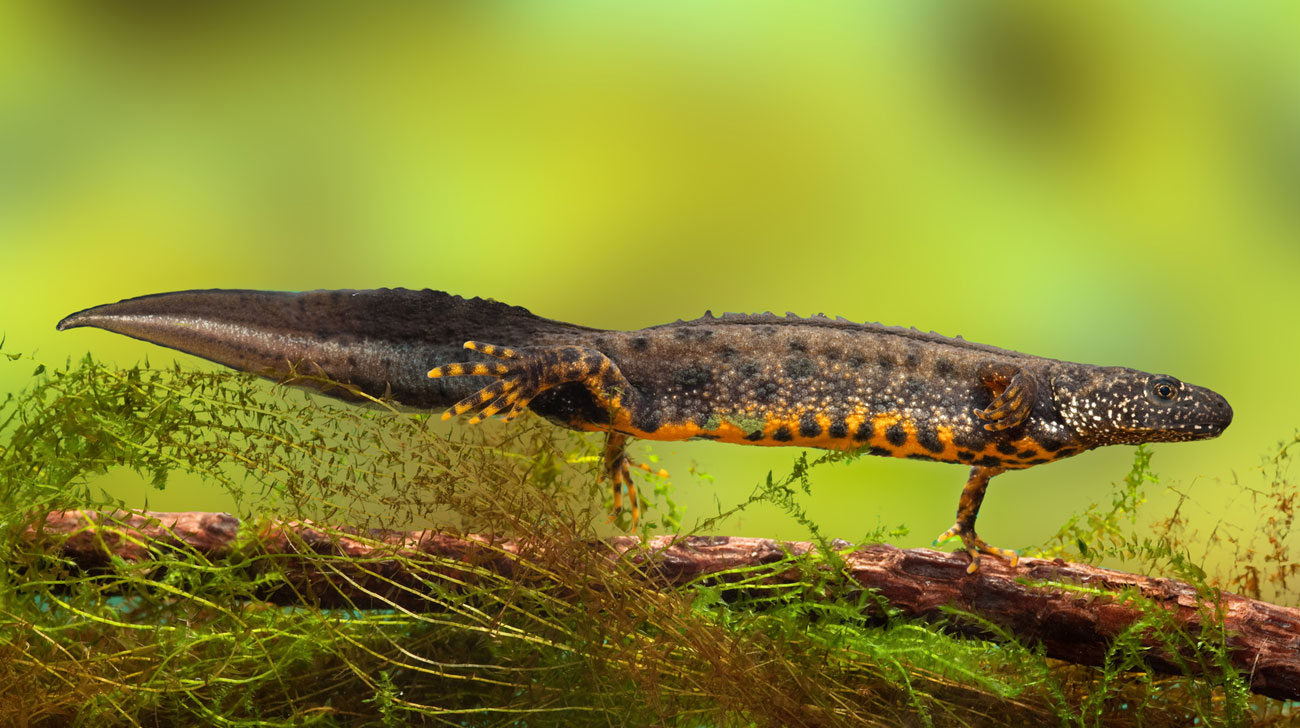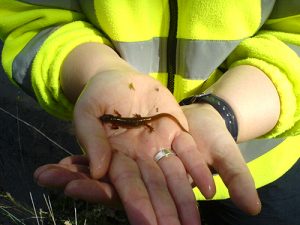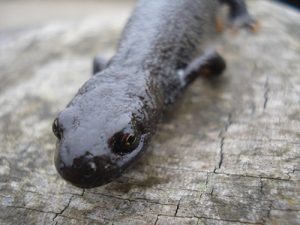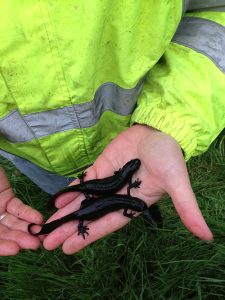
Our ecological consultants are licenced to conduct great crested newt surveys in both England and Wales and have extensive knowledge, skills and practical know how to guide you through the whole process.
We can offer a range of options to assess the likelihood for great crested newts to be encountered on your development site and we have all the necessary credentials to obtain a great crested newt licence to help secure planning permission for your scheme.
Why do I need a newt survey?
Great crested newts are a European protected species. The animals, its eggs and their breeding sites and resting places are protected by law. If your local planning authority, architect or planning agent have requested a great crested newt survey it is because they consider the likelihood of newts being affected by the development proposal as reasonable.
Great Crested Newts Survey Methodology:

Habitat Suitability Index Assessment:
The habitat suitability index was developed to determine the suitability of a waterbody to support great crested newts. It is also frequently referred to as a great crested newt HSI survey or walkover survey. This is an assessment method that can be used to ascertain if a great crested newt presence/absence survey will be required in relation to your site or activity. Our ecologists use this technique to both inform you of the need for further traditional presence / absence surveys and to indicate which ponds are likely to offer the most sound survey data.
A HSI assessment can be carried out at any time of year and is conducted during daylight hours.
Presence / Absence surveys:
This is the most traditional technique used for ascertaining whether or not great crested newts are present or absent in your locality. It is also frequently referred to as a great crested newt trapping survey. This survey technique requires our ecologists to attend any waterbodies or ponds within 250m of your development plot or 500m for larger scale developments to deploy a minimum of three survey techniques across four visits including torch light surveying and bottle trapping overnight and egg searches during daylight hours. This is a licensable activity and our ecological consultants have all the necessary authorisation to conduct this newt survey on your behalf.
If great crested newts are identified within any of the waterbodies during the four visits, the survey effort will be extended to six nights in order to obtain what is known as a population size class assessment. This level of sound survey data is essential should we need to apply for an EPS licence or mitigation licence for your scheme.
Permission to conduct great crested newt presence/absence surveys is seasonally restricted to between March and June. There is a further requirement within this timeframe to have conducted at least two of the survey visits between mid-April and mid-May. If you are seeking a great crested newt survey outside this window of opportunity our ecological consultants can look to alternative survey methods such as HSI or eDNA if appropriate to your project. Alternatively, if you want to ensure you have your full survey report available as soon as possible for planning submission, you can reserve your great crested newt presence/absence survey with our ecologists for the first available opportunity in the following survey season. To book your survey contact us.

eDNA for Great Crested Newts:
eDNA testing for great crested newts is an ecological service that our expert ecologists are fully licensed to undertake for you. Collection and analysis of water samples from a pond can detect if newts are present. This technique benefits clients with cost and time savings in comparison to conventional newt survey techniques plus in some cases can offer an extended survey window.
If the sample indicates a negative score there will be no likely further requirement to survey or address this species for your planning permission. A positive score will be used to inform you of the need to proceed to traditional survey methods in order to obtain a population size class assessment for obtaining your EPS development licence.
What happens next?
We will make sure you receive a full report containing the results and also all relevant recommendations based on our findings during the newt surveys. The price of the survey includes the report costs. The report will help you understand better the type and level of mitigation that may be needed. If allowed by the scope of your proposals for development, Contract Ecology Ltd will also try to design a comprehensive ecological solution that will eliminate the need for you to obtain an EPS Licence (European Protected Species).
Great crested newt mitigation:
Apart from carrying out newt surveys our ecologists can also put forward a strategy, if your proposals allow, that will safeguard the animals through reasonable avoidance measures and a precautionary works method statement and get your development proposals through planning likely to include our ecologists attending your site to conduct ecological supervision under Ecological Clerk of Works duties (ECoW). If you’re planning an activity that can’t avoid disturbing great crested newts or damaging their habitats, our ecologists can apply for a mitigation licence.

Contract Ecology Ltd is unique in its industry as we own and operate our own specialist low impact plant and equipment that allows us to install great crested newt exclusion fencing and pitfall traps around the perimeter of your site. The purpose of this fencing is to allow our ecologists to capture any amphibians including great crested newts that are present on your site and move them to a safe zone beyond the fencing so granting you a newt free site to commence your works on without further restriction. The exclusion fencing will remain around the perimeter of your site until you have finished your building works so to ensure that newts do not re-enter your site and come to any harm during your construction activities. Once your build is finished the fencing can be removed.
We offer a choice of newt exclusion fencing options dependent on your site specific requirements. Full details of our wildlife fencing range is available HERE